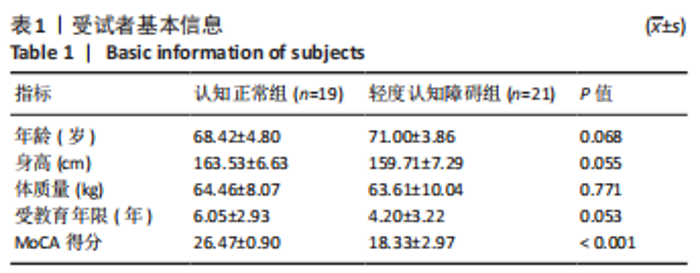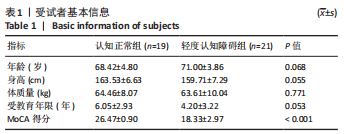Chinese Journal of Tissue Engineering Research ›› 2024, Vol. 28 ›› Issue (24): 3897-3902.doi: 10.12307/2024.602
Previous Articles Next Articles
Effect of support surface stability on balance in the elderly with mild cognitive impairment under different visual input conditions
Qi Liuxin1, Zhou Mian2, Wang Xiangyu3, Sun Wei1, Wang Jiangna1
- 1Shandong Sport University, Jinan 250102, Shandong Province, China; 2People’s Hospital of Weishan, Jining 277600, Shandong Province, China; 3Shandong Sports Rehabilitation Research Center, Jinan 250100, Shandong Province, China
-
Received:2023-06-12Accepted:2023-07-15Online:2024-08-28Published:2023-11-21 -
Contact:Wang Jiangna, Associate professor, Shandong Sport University, Jinan 250102, Shandong Province, China -
About author:Qi Liuxin, Master candidate, Shandong Sport University, Jinan 250102, Shandong Province, China -
Supported by:Shandong Natural Science Foundation, No. ZR2020QC091 (to WJN); National Natural Science Foundation of China, No. 31700815 (to SW); National College Student Innovation and Entrepreneurship Training Program, No. S202210457002 (to SW)
CLC Number:
Cite this article
Qi Liuxin, Zhou Mian, Wang Xiangyu, Sun Wei, Wang Jiangna. Effect of support surface stability on balance in the elderly with mild cognitive impairment under different visual input conditions[J]. Chinese Journal of Tissue Engineering Research, 2024, 28(24): 3897-3902.
share this article
Add to citation manager EndNote|Reference Manager|ProCite|BibTeX|RefWorks

2.2 睁眼时的静态平衡能力 图1显示,2组人群睁眼条件下在不同支撑面上的总摇摆路径(F=7.37,P=0.008,η2=0.088)、内外总摇摆路径(F=7.16,P=0.009,η2=0.086)和95%椭圆置信面积指标(F=7.80,P=0.007,η2=0.093)交互作用显著。事后分析显示,MCI组在硬支撑面上的内外总摇摆路径(P < 0.001,Cohen’s d=1.45)和95%椭圆置信面积(P < 0.001,Cohen’s d=1.35)显著高于认知正常组。MCI组在软支撑面上的总摇摆路径(P=0.003,Cohen’s d=0.92)、内外总摇摆路径(P=0.001,Cohen’s d=1.20)和95%椭圆置信面积(P=0.001,Cohen’s d=1.17)显著高于认知正常组。MCI组在软支撑面上的总摇摆路径(P < 0.001,Cohen’s d=2.14)、内外总摇摆路径(P < 0.001,Cohen’s d=2.18)和95%椭圆置信面积(P < 0.001,Cohen’s d=1.53)显著高于其站在硬支撑面。"
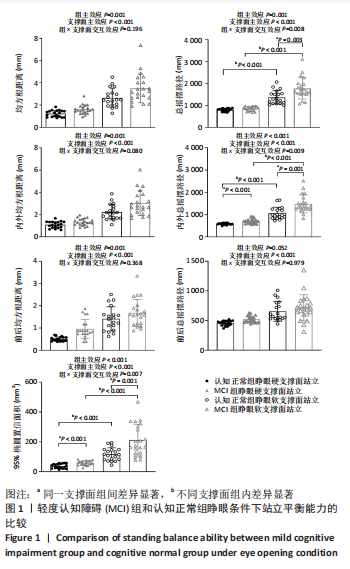
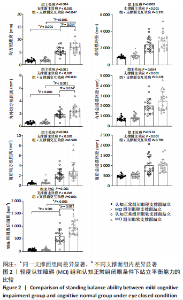
2.3 闭眼时的静态平衡能力 图2显示,2组人群闭眼条件下在不同支撑面上的95%椭圆置信面积(F=11.37,P=0.001,η2=0.13)、均方根距离(F=4.09,P=0.047,η2=0.051)和内外均方根距离(F=4.30,P=0.041,η2=0.054)指标交互作用显著。事后分析显示,与认知正常组相比,MCI组在硬支撑面上的95%椭圆置信面积、均方根距离和内外均方根距离没有发现显著的组间差异(P > 0.05)。MCI组在软支撑面上的95%椭圆置信面积(P=0.001,Cohen’s d=1.14)、均方根距离(P=0.014,Cohen’s d=0.79)和内外均方根距离(P=0.014,Cohen’s d=0.80)显著高于认知正常组。MCI组在软支撑面上的95%椭圆置信面积(P < 0.001,Cohen’s d=3.46)、均方根距离(P < 0.001,Cohen’s d=2.35)和内外均方根距离(P < 0.001,Cohen’s d=2.50)显著高于其站在硬支撑面。"
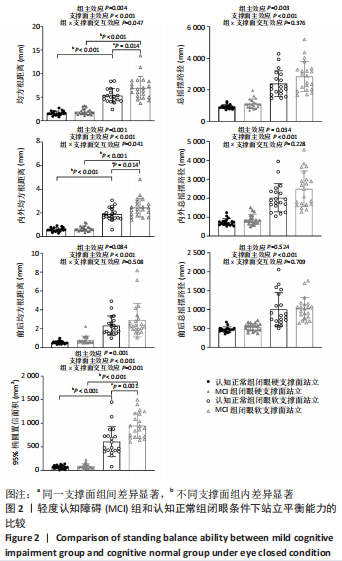
| [1] CHEN YX, LIANG N, LI XL, et al. Diagnosis and Treatment for Mild Cognitive Impairment: A Systematic Review of Clinical Practice Guidelines and Consensus Statements. Front Neurol. 2021;12:719849. [2] XUE J, LI J, LIANG J, et al. The Prevalence of Mild Cognitive Impairment in China: A Systematic Review. Aging Dis. 2018;9(4):706-715. [3] JEON SY, HAN SJ, JEONG JH, et al. Effect of exercise on balance in persons with mild cognitive impairment. NeuroRehabilitation. 2014;35(2):271-278. [4] MONTERO-ODASSO M, SPEECHLEY M. Falls in Cognitively Impaired Older Adults: Implications for Risk Assessment And Prevention. J Am Geriatr Soc. 2018;66(2):367-375. [5] 朱玲玲,绳宇,常红,等.双重任务训练对改善血管性轻度认知障碍老年人步态和平衡功能的效果 [J].中国护理管理,2021,21(11):1660-1665. [6] BAHUREKSA L, NAJAFI B, SALEH A, et al. The Impact of Mild Cognitive Impairment on Gait and Balance: A Systematic Review and Meta-Analysis of Studies Using Instrumented Assessment. Gerontology. 2017;63(1):67-83. [7] 魏书侠,池秋路.老年轻度认知障碍患者跌倒风险及干预研究[J].解放军预防医学杂志,2016,34(5):66-67. [8] RACEY M, MARKLE-REID M, FITZPATRICK-LEWIS D, et al. Fall prevention in community-dwelling adults with mild to moderate cognitive impairment: a systematic review and meta-analysis. BMC Geriatr. 2021;21(1):689. [9] DELBAERE K, KOCHAN NA, CLOSE JC, et al. Mild cognitive impairment as a predictor of falls in community-dwelling older people. Am J Geriatr Psychiatry. 2012;20(10):845-853. [10] MIGNARDOT JB, BEAUCHET O, ANNWEILER C, et al. Postural sway, falls, and cognitive status: a cross-sectional study among older adults. J Alzheimers Dis. 2014;41(2):431-439. [11] CHANTANACHAI T, TAYLOR ME, LORD SR, et al. Risk factors for falls in community-dwelling older people with mild cognitive impairment: a prospective one-year study. PeerJ. 2022;10:e13484. [12] RODRIGUES ACMA, TININI RCDR, GATICA-ROJAS V, et al. Motor-cognitive dual-task performance of older women evaluated using Wii Balance Board. Aging Clin Exp Res. 2020;32(5):907-912. [13] 王露,蔡蕊琳,张宽,等. 肥胖儿童短时间静态平衡特征[J].医用生物力学,2021,36(6):957-962. [14] 刘鑫玥,霍洪峰.认知负荷对人体静态平衡及动态稳定性的影响[J].医用生物力学,2021,36(S1):360. [15] SONG Q, ZHANG X, MAO M, et al. Relationship of proprioception, cutaneous sensitivity, and muscle strength with the balance control among older adults. J Sport Health Sci. 2021;10(5):585-593. [16] DESCHAMPS T, BEAUCHET O, ANNWEILER C, et al. Postural control and cognitive decline in older adults: position versus velocity implicit motor strategy. Gait Posture. 2014;39(1):628-630. [17] QUIJOUX F, VIENNE-JUMEAU A, BERTIN-HUGAULT F, et al. Center of pressure displacement characteristics differentiate fall risk in older people: A systematic review with meta-analysis. Ageing Res Rev. 2020;62:101117. [18] QUIJOUX F, NICOLAÏ A, CHAIRI I, et al. A review of center of pressure (COP) variables to quantify standing balance in elderly people: Algorithms and open-access code. Physiol Rep. 2021;9(22):e15067. [19] MCGOUGH EL, HSU LY, THOMPSON H, et al. Concurrent Validity of Postural Sway Measures in Older Adults with Cognitive Impairment. Phys Occup Ther Geriatr. 2018;36(4):399-410. [20] SEGAL AD, YEATES KH, NEPTUNE RR, et al. Foot and Ankle Joint Biomechanical Adaptations to an Unpredictable Coronally Uneven Surface. J Biomech Eng. 2018;140(3). doi: 10.1115/1.4037563. [21] HSIAO D, BELUR P, MYERS PS, et al. The impact of age, surface characteristics, and dual-tasking on postural sway. Arch Gerontol Geriatr. 2020;87:103973. [22] PALAZZO F, NARDI A, LAMOUCHIDELI N, et al. The effect of age, sex and a firm-textured surface on postural control. Exp Brain Res. 2021;239(7):2181-2191. [23] 纪仲秋,张静,姜桂萍,等.老年男性与青年男性静态平衡能力的差异性研究[J].中国康复医学杂志,2019,34(6):648-655. [24] PETERSEN RC, LOPEZ O, ARMSTRONG MJ, et al. Practice guideline update summary: Mild cognitive impairment: Report of the Guideline Development, Dissemination, and Implementation Subcommittee of the American Academy of Neurology. Neurology. 2018;90(3):126-135. [25] CIESIELSKA N, SOKOŁOWSKI R, MAZUR E, et al. Is the Montreal Cognitive Assessment (MoCA) test better suited than the Mini-Mental State Examination (MMSE) in mild cognitive impairment (MCI) detection among people aged over 60? Meta-analysis. Psychiatr Pol. 2016;50(5):1039-1052. [26] MONTERO-ODASSO M, MUIR SW, SPEECHLEY M. Dual-task complexity affects gait in people with mild cognitive impairment: the interplay between gait variability, dual tasking, and risk of falls. Arch Phys Med Rehabil. 2012; 93(2):293-299. [27] SHIN BM, HAN SJ, JUNG JH, et al. Effect of mild cognitive impairment on balance. J Neurol Sci. 2011;305(1-2):121-125. [28] NASREDDINE ZS, PHILLIPS NA, BÉDIRIAN V, et al. The Montreal Cognitive Assessment, MoCA: a brief screening tool for mild cognitive impairment. J Am Geriatr Soc. 2005;53(4):695-699. [29] 华安珂.触觉对静态站姿稳定性的影响[D].杭州:浙江大学, 2019. [30] SONG Q, LI L, ZHANG C, et al. Long-term Tai Chi practitioners have superior body stability under dual task condition during stair ascent. Gait Posture. 2018;66:124-129. [31] SUN W, WANG L, ZHANG C, et al. Detraining effects of regular Tai Chi exercise on postural control ability in older women: A randomized controlled trial. J Exerc Sci Fit. 2018;16(2):55-61. [32] SUN TL, LEE CH. An impact study of the design of exergaming parameters on body intensity from objective and gameplay-based player experience perspectives, based on balance training exergame. PLoS One. 2013;8(7): e69471. [33] PRIETO TE, MYKLEBUST JB, HOFFMANN RG, et al. Measures of postural steadiness: differences between healthy young and elderly adults. IEEE Trans Biomed Eng. 1996;43(9):956-966. [34] TERRA MB, DA SILVA RA, BUENO MEB, et al. Center of pressure-based balance evaluation in individuals with Parkinson’s disease: a reliability study. Physiother Theory Pract. 2020;36(7):826-833. [35] RUHE A, FEJER R, WALKER B. The test-retest reliability of centre of pressure measures in bipedal static task conditions--a systematic review of the literature. Gait Posture. 2010;32(4):436-445. [36] LI Z, LIANG YY, WANG L, et al. Reliability and validity of center of pressure measures for balance assessment in older adults. J Phys Ther Sci. 2016; 28(4):1364-1367. [37] LEANDRI M, CAMMISULI S, CAMMARATA S, et al. Balance features in Alzheimer’s disease and amnestic mild cognitive impairment. J Alzheimers Dis. 2009;16(1):113-120. [38] 王志伟,金建烽,严清章,等.轻度认知障碍患者平衡功能与视空间感知功能的关系[J].中国健康心理学杂志,2016,24(12):1778-1782. [39] XIA R, REN J, LI X, et al. Alterations in Corticocortical Vestibular Network Functional Connectivity Are Associated with Decreased Balance Ability in Elderly Individuals with Mild Cognitive Impairment. Brain Sci. 2022;13(1):63. [40] NOOHI F, KINNAIRD C, DE DIOS Y, et al. Age Differences in Vestibular Brain Connectivity Are Associated With Balance Performance. Front Aging Neurosci. 2020;12:566331. [41] SUN W, MA X, WANG L, et al. Effects of Tai Chi Chuan and Brisk Walking Exercise on Balance Ability in Elderly Women: A Randomized Controlled Trial. Motor Control. 2019;23(1):100-114. [42] 白安颖,胡亦新,徐伟豪,等.北京市社区高龄老年人轻度认知障碍的患病率及其与性别和肌少症的相关性[J].中国临床保健杂志,2021, 24(2):175-182. [43] 郑鑫虎.高龄轻度认知障碍老年人体力活动水平、下肢肌力、步态特征与跌倒风险的关系研究 [D].上海:上海体育学院,2021. [44] HORAK FB. Postural orientation and equilibrium: what do we need to know about neural control of balance to prevent falls? Age Ageing. 2006;35 Suppl 2:ii7-ii11. [45] TANAKA H, UETAKE T. Characteristics of postural sway in older adults standing on a soft surface. J Hum Ergol (Tokyo). 2005;34(1-2):35-40. |
| [1] | Hou Zexin, Xu Benke, Dai Yuan, He Chuan, Zhang Chaoju, Li Xiaolin. Finite element analysis of the mechanism of dorsiflexion injury of wrist joint in elderly people after falls [J]. Chinese Journal of Tissue Engineering Research, 2024, 28(6): 886-890. |
| [2] | Li Zhipeng, Huan Dawei, Yuan Zhaofeng, Ding Kai, Qiu Yue, Xia Tianwei, Shen Jirong. Mid- and long-term state after total hip arthroplasty versus hemiarthroplasty for femoral neck fractures in the elderly: evaluation using propensity score matching method [J]. Chinese Journal of Tissue Engineering Research, 2024, 28(24): 3839-3844. |
| [3] | Zhang Guohui, Tian Weifeng, Li Hua, Wang Quan, Liu Yanhui, Guan Yulong, Xiao Chunlai. A controlled trial of elastic fixation and absolute fixation for treatment of ankle fractures with lower tibiofibular instability [J]. Chinese Journal of Tissue Engineering Research, 2024, 28(24): 3862-3866. |
| [4] | Xu Daxing, Ji Muqiang, Tu Zesong, Xu Weipeng, Xu Weilong, Niu Wei. Constructing a risk prediction model for failure after locking plate fixation for proximal humeral fractures in the elderly by combining the deltoid tuberosity index with preoperative factors [J]. Chinese Journal of Tissue Engineering Research, 2024, 28(21): 3299-3305. |
| [5] | Li Zhipeng, Huan Dawei, Yuan Zhaofeng, Qiu Yue, Zhang Chao, Xia Tianwei, Shen Jirong. Risk factors of postoperative mortality of femoral neck fractures in elderly patients and construction of a nomogram predictive model [J]. Chinese Journal of Tissue Engineering Research, 2024, 28(21): 3361-3366. |
| [6] | Zhu Shijie, Yang Yiting, Cao Yuting, Zheng Liangdong, Lin Kaili, Zhu Rui. Cartilage protective effect of swimming exercise in aged mice with knee osteoarthritis [J]. Chinese Journal of Tissue Engineering Research, 2024, 28(20): 3170-3175. |
| [7] | Shi Jiao, Li Xingjie, Liu Qiqi, Liu Jun, Yuan Xu, Chen Shangjie. Effect of electronic moxibustion on the volume of hippocampal subregion in patients with amnestic mild cognitive impairment [J]. Chinese Journal of Tissue Engineering Research, 2024, 28(20): 3176-3181. |
| [8] | Li Peng, Han Xiaosong, Xiang Bingyan, He Yingyi, Huang Kun, Liu Li, Luo Hongjian, Ruan Shiqiang. Application and economic effects of digital three-dimensional reconstruction in hip hemiarthroplasty for intertrochanteric femoral fractures in the elderly [J]. Chinese Journal of Tissue Engineering Research, 2024, 28(18): 2814-2818. |
| [9] | Chang Feng, Li Yanlong. Fracture risk analysis and prediction of low bone mass tangential points in middle-aged and elderly women with different chronic diseases [J]. Chinese Journal of Tissue Engineering Research, 2024, 28(14): 2140-2144. |
| [10] | Zhong Jiamin, Huang Zhaoxin, Li Longxue, Qu Tongtong, Liu Zhuang, Fu Yifeng, Xiao Xiaofei. Effects of visual factors on balance function in young adults [J]. Chinese Journal of Tissue Engineering Research, 2023, 27(8): 1245-1249. |
| [11] | Shen Lianwei, Zhu Hongliu, Wang Wei. Risk factor analysis of metabolic syndrome and construction of a nomogram prediction model in middle-aged and elderly people [J]. Chinese Journal of Tissue Engineering Research, 2023, 27(5): 657-662. |
| [12] | Ma Shengnan, Ke Jingyue, Dong Hongming, Shen Shuang, Ding Hao, Li Jianping, Li Guqiang. Balance and gait characteristics of static standing and walking after anterior cruciate ligament reconstruction [J]. Chinese Journal of Tissue Engineering Research, 2023, 27(36): 5784-5789. |
| [13] | Wang Tianhao, Liang Xiaolong, Zheng Kai, Li Rongqun, Zhou Jun, Geng Dechun, Xu Yaozeng, Zhu Feng. Comparison of short-term follow-up results between femoral neck system and cannulated compressive screws in the treatment of femoral neck fracture in the elderly [J]. Chinese Journal of Tissue Engineering Research, 2023, 27(36): 5828-5833. |
| [14] | Niu Feng, Su Baotong, Chen Yulin, Xie Yajuan, Xu Yilang, Li Cong, Cheng Zhian. Establishment of Nomogram prediction model for postoperative blood transfusion in elderly hip fractures using R software [J]. Chinese Journal of Tissue Engineering Research, 2023, 27(31): 4932-4936. |
| [15] | Zhu Hongliu, Wang Wei. Correlation analysis of low back pain in middle-aged and elderly people in China and construction of a linear graph prediction mode [J]. Chinese Journal of Tissue Engineering Research, 2023, 27(31): 4937-4942. |
| Viewed | ||||||
|
Full text |
|
|||||
|
Abstract |
|
|||||
